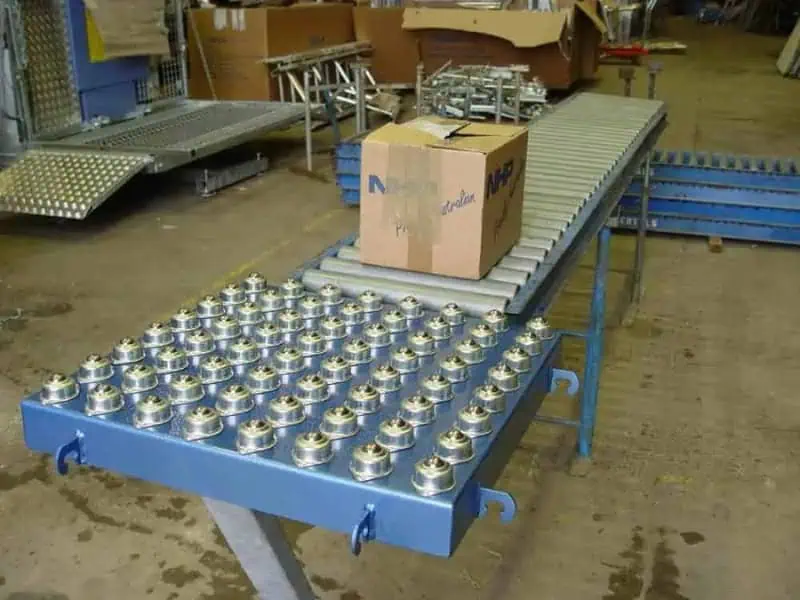For many warehouse tasks, gravity roller conveyor systems deliver a smarter balance of cost, speed, and flexibility than powered lines. Short runs, frequent touches, and simple hand-offs suit gravity, while long, controlled, or uphill moves favour powered units. This article explains how gravity works, where it shines, and when powered is the better bet so that you can make a call without guesswork. This article, written for busy ops teams, cuts through the noise with clear guidance on gravity roller conveyor systems, practical selection cues, and real-world setup tips.
What are the main components of gravity roller conveyor systems?
A gravity roller conveyor uses a modular frame, rollers, and adjustable stands to guide cartons with minimal parts and fuss. At Conveying & Hoisting Solutions, gravity roller conveyor systems are built with robust frames and high-quality rollers designed for reliability and ease of setup. These core parts prioritise durability and swap-out simplicity, so maintenance and reconfiguration stay quick.
- Frames: Rigid channels that hold roller sets in aligned, modular sections.
- Rollers: Steel or PVC cylinders sized to load, standard diameter 50 mm for hire fleets.
- Pitch: Centre-to-centre spacing (often 75 mm) set by the smallest carton length.
- Side guides: Low-profile rails that keep boxes tracking true on declines.
- Stands: Adjustable legs (commonly 540–840 mm) that set height and slope.
- End stops: Mechanical stops that prevent overrun at discharge points.
A simple bill of materials helps minimise maintenance and downtime. In short, components are rugged, replaceable, and too easy to reconfigure.
How do gravity roller conveyor systems move materials without motors?
Cartons roll because a slight decline converts weight into motion, and low-friction bearings keep the glide going.
- Slope: A slight gradient (about 2–5%) over short runs starts and sustains movement.
- Load base: Flat, rigid bottoms roll predictably; soft or uneven bases may stall.
- Bearings: Quality bearings reduce start force and stabilise speed on light loads.
- Control points: End stops and short braking sections manage arrival at hand-offs.
- Layout: Straight lanes with 90° bends handle layout changes without wiring.
The takeaway: set slope with your toughest carton, then trim the last millimetre for smooth, safe flow.
Why are gravity roller conveyor systems ideal for short-distance product handling?
They excel at short, repeatable tasks involving cartons moving between benches, pack stations, and dispatch with minimal automation.
- Fast setup: Tool-light assembly means lanes go in before smoko, not after.
- Low capex: Frames and rollers cost less than motors, gearboxes, and controls.
- Quiet operation: No motors reduce noise fatigue and keep comms clear.
- Easy reconfiguration: Add 3 m straights or 90° bends as processes change.
- Ergonomics: Height-set stands bring cartons to elbow level, reducing bending.
Mid-sentence and right where it helps, add efficient gravity roller conveyor systems for smooth product movement to link operators, benches, and scales in one smooth pass without complex electrics. In summary, short runs with frequent touches are home turf for gravity; keep distances modest and slopes gentle for best results.
When should you choose a gravity roller conveyor over a powered conveyor?
Choose gravity for flexible, short runs with predictable cartons; choose powered when you need fixed speeds, uphill transport, or automation.
- Decision lens: Match speed control, distance, and incline needs to each station.
- Hybrid thinking: Utilise powered infeed and gravity offload to reduce spend and risk.
- Exception handling: Let people manage outliers; keep lanes for the common case.
- Space use: Slim frames fit tight cells where motors would cramp access.
Here’s an estimated, alignment-friendly cheat sheet based on typical hire specs.
| Section type | Length (mm) | Roller width (mm) | Roller Ø (mm) |
| Straight | 3000 | 385 | 50 |
| 90° bend | 1700 | 385 | 50 |
| Extension straight | 1500 | 385 | 50 |
These figures mirror standard hire options—3 m straights, 90° bends, 50 mm rollers, and 75 mm pitch—while height comes from adjustable stands. Ultimately, gravity wins on simplicity; powered wins where speed discipline is non-negotiable.
What industries benefit most from hiring roller conveyor equipment?
Sectors with seasonal spikes, pop-up sites, or short projects gain the most from temporary roller conveyor hire.
- Retail distribution: Peak picks, returns triage, and promo pack-outs that last weeks, not years.
- FMCG and beverage: Offload stations and consolidation lines that move with mobile fillers.
- Construction fit-out: Staging for joinery, fixtures, and finishing kits on changing floors.
- Events and exhibitions: Temporary back-of-house pack benches and merch lanes.
- 3PLs and startups: Trial lanes before committing to full automation.
Because safety is non-negotiable, align guarding, signage, and training with machinery operation safety standards in Australia. A short pre-start chat, clear walkways, and labelled pinch points keep crews safe as houses. Overall, hire suits teams that need flexibility, not a ball-and-chain of permanent kit.
How can adjustable roller stands improve material flow efficiency?
Adjustable stands control height and slope, turning stop-start movement into steady rolling with minor, precise tweaks.
- Height matching: Set lanes level with benches and scales to prevent lip snags.
- Fine slope control: Nudge the gradient to the point where the slowest carton moves.
- Floor variability: Compensate for uneven slabs with independent leg adjustment.
- Repeatability: Mark legs and record set-points to lock in a successful setup.
- Stability: Cross-brace tall stands and lock castors to prevent shimmy.
Dial in stands during commissioning with three SKUs—light, average, heavy—and confirm merges and hand-offs at working pace. In brief, accurate stand settings are the quiet achiever that makes everything else tickety-boo.
Final thoughts on selecting the best conveyor hire option
Select the appropriate tool for each station instead of using a one-size-fits-all approach. Use gravity on short, busy cells; add powered where uphill or strict speed control is required; and keep layouts modular so changes aren’t a hassle when demand swings like a wet sail. For planning, map touch points, design short test lanes, and record stand settings so the night shift inherits a smooth-running setup. Mid-sentence and with zero fuss, ask Conveying & Hoisting Solutions about flexible conveyor rental options to lock dates and quantities without overcommitting.




